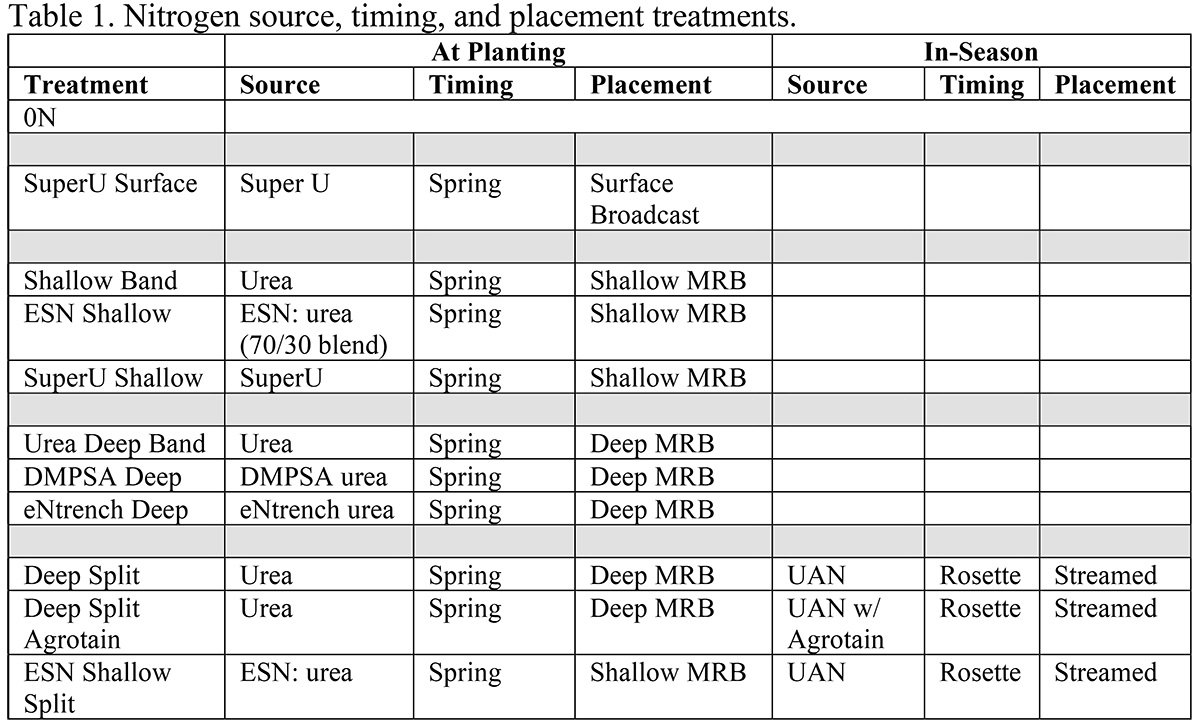Optimal source, placement and application timing for yield and reduction of greenhouse gas footprint for canola production on light texture soils
Term: 3 years ending March 2022
Status: Complete
Researcher(s): Mario Tenuta, University of Manitoba
SaskCanola Investment: $232,920
Total Project Cost: $77,640
Funding Partners: MCGA
Grower Benefits
Shallow banded urea (0.75-1”) had the highest cumulative emissions of nitrous oxide (N2O) followed by deep banded urea (3-4”) at planting. The lowest emissions and near that of the 0 N control were deep banded DMPSA urea and shallow banded SuperU. eNtrench urea was intermediate between the highest emission treatment and the lowest (0 N control).
Split application where UAN was streamed in-season at rosette stage reduced emissions compared to shallow and deep banded urea at planting.
The results confirm previous findings that shallow banded urea increases nitrous oxide (N2O) emissions, and that nitrification-inhibited urea (either single or dual) be used when shallow banding. The results also confirm that single and dual-inhibited urea products can both reduce emissions effectively.
Project Summary
The federal government has committed to reducing emissions 30% below 2005 levels by 2030. Beyond implementing 4R Nutrient Stewardship practices of applying nitrogen (N) at the right rate, source, time and place, there are other opportunities for further reductions through rate and emission reductions. These include better management of fall applied N, use of enhanced efficiency fertilizer products, management of depth of N placement and utilization of in-season N application. The objective of this project is to determine the best combination of fertilizer source, placement, and timing to maximize yield, improve fertilizer N use efficiency and reduce losses of N2O and ammonia (NH3) on light textured soil (sandy loam) in south-central Manitoba.
Two sites were selected each year for three years and were not sited on the same location between years to avoid a canola-on-canola rotation. Each site had 36 combinations of treatments (Table 1). The rate used was 100% of the soil test recommendation. Triple superphosphate (0-46-0) was applied at 13.5 kg/ha (12 lb/ac) with the seed. After seeding, spring treatments were monitored for greenhouse gas emissions, N2O, and NH3 volatilization losses. Soil samples were collected six times throughout the growing season for each site to calculate extractable soil nitrogen and weather and precipitation was monitored regularly.
For ease of interpreting the N2O emission results, the treatments were put into four treatment groups. For each group, the SuperU surface at planting (a BMP when subsurface application is not possible) and 0 N control (background emissions levels) serve as reference treatments.
Placement and split group: Urea shallow, urea deep and split application. Testing effect of mid-row band depth and split application of urea.
Source group: ESN shallow, urea shallow and SuperU shallow. Testing effect of a controlled release and dual-inhibited urea product on reducing emissions from shallow mid-row banding.
Deep source group: DMPSA deep, urea deep and eNtrench deep. Testing effect of nitrification inhibition alone on the conventional banding depth of urea.
Split group: Deep split urea, deep split Agrotain and ESN shallow split. Testing the effect of splitting N application between at planting and rosette stage and effect of urease inhibitor of rosette-streamed UAN and ESN blend at planting followed by rosette-streamed UAN.
In 2019, shallow banded urea was a high emission treatment and SuperU surface applied, SuperU shallow banded, ESN shallow banded and DMPSA deep banded had low emissions. In 2020, urea shallow and deep banded applications had the highest emissions. In both 2020 and 2021, enhanced efficiency nitrogen products containing a nitrification inhibitor or being controlled released (ESN shallow banded) had lower emissions. One site in 2021 had higher emissions for shallow banded urea and less for deep banded urea than the other treatments.
For the depth and split treatment group, shallow and deep banded urea had significantly higher emissions than deep split, SuperU surface and the 0 N control (these three treatments did not differ). Among all the shallow treatments (source group), shallow banded urea was significantly higher than other treatments. The SuperU treatments either shallow or surface applied were not different from the 0 N control. The ESN shallow was lower in emissions than urea shallow, but higher than SuperU surface. For the deep source group, deep banded urea was significantly higher in cumulative emission than other treatments. eNtrench deep had lower emissions than urea deep, but higher than the control. DMPSA deep was much lower than urea deep and no different than the control. SuperU surface was lower in emissions than urea deep, but not different than eNtrench or DMPSA. The interaction between treatment and site was significant for the split treatment group. For four of the six sites, there were no differences, but for one site in 2019 and one site in 2020, the split Agrotain had higher emissions than SuperU surface and the control. Across all sites, the order of treatment was significantly greater in cumulative emissions than the control (shallow banded urea > deep banded urea > ESN shallow > deep split. The nitrification alone treatment, DMPSA deep, had nearly the same emissions as the control (Figure 1).
Figure 1. Cumulative N2O emissions during the growing season by treatment across all sites. Treatments above the horizontal line are significantly different from the 0 N control.


